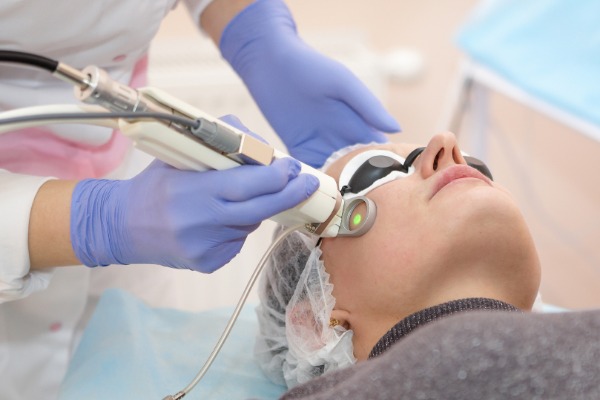
Procedure Time: 15-60 mins depending on size of area
Recovery Time: 1-2 weeks
Results Duration: Several years
Cost: From £1,000- £4,000
Anaesthesia: Local anaesthesia and/or sedation
For a full list of FAQs please Click Here.
Since the early 1990s, lasers have become the high tech equivalent of dermabrasion or deep chemical peels for skin resurfacing; the removal of the outer layer of the skin to promote new fresh skin growth. There are two main types of ablative laser - carbon dioxide lasers, and erbium:YAG laser systems. These skin resurfacing lasers briefly direct an intense burst of laser energy onto the skin. This energy heats water within the surface layers of the skin, causing both the water and the tissue to turn to vapour. Every time the laser passes over the skin, some of the outermost layers are removed in a precise and controlled way to the appropriate depth. The skin then heals over a period of time as new layers of collagen are produced. This can significantly reduce the appearance of lines, wrinkles, and pigment changes on the face, neck, and body. Immediately after resurfacing, you will have a raw, uncomfortable and weeping surface burn which will take 3 - 8 days to heal. Most people find that they can return to work after a couple of weeks. Private costs can range from approx. £1,000 for a small area to £4,000 for full face laser skin resurfacing.
Do you have a question? Ask one of our experts NOWThe use of light as a medical treatment has grown considerably over the past few years. There are now many kinds of devices, which deliver various different types of light for an ever-increasing number of potential uses.
Ultra - Violet light, for example, has been used to treat psoriasis (a skin disease) for a number of years, and many people use light boxes during the winter to reduce the symptoms of seasonal affective disorder (SAD). Simply, exposure to certain kinds of light often makes people feel better!
The use of light from lasers for medical procedures was developed in the 1960s when they were first used as cutting tools in operations by some surgeons.
Laser technology has developed over the last few decades to treat patients with a variety of different skin problems including the effects of sun damage, the removal of body hair and recently the treatment of psoriasis and acne.
Lasers are also commonly used by ophthalmologists (eye specialists) for the treatment of certain eye conditions, and there are also now numerous private clinics offering laser treatment as a solution to short sightedness.
Since the early 1990s, lasers have become the high tech equivalent of dermabrasion or deep chemical peels for skin resurfacing (removal of the outer layer of the skin).
Figures from the American Society for Aesthetic Plastic Surgery (ASAPS.) indicate that full field ablative laser skin resurfacing was performed in 31,033 treatments in the USA in 2019, a decrease of 18% on 2018 statistics. A significant increase in the use of fractional laser resurfacing during this same period may explain the sudden drop, however, all types of ablative and non-ablative laser treatments remain popular.
Similar statistics are not available for the United Kingdom, but this procedure has probably declined in popularity due to the development of less aggressive light treatments aimed at skin rejuvenation.
This is particularly the case since the advent of a newer type of procedure using fractional lasers for resurfacing skin has become more popular as a less aggressive alternative to ablative lasers in recent years.
If you are considering laser skin resurfacing the following information will give you a basic understanding of the procedure. It can't answer all your questions, since a lot depends on the individual patient and the practitioner. Please ask a practitioner about anything you don't understand.
A laser is a high-energy beam of light that can be directed into certain areas or tissues within the skin. These beams of light are produced in one wavelength or colour at a time, and can vary in terms of their strength and the type of tissue that they can target.
Ablative Lasers
So - called "ablative" or skin resurfacing lasers briefly direct an intense burst of laser energy onto the surface of the skin. This energy heats water within the surface layers of the skin, causing both the water and the tissue of the skin to turn to vapour.
Every time the laser passes over the skin, some of the outermost layers of the skin are removed in a precise and controlled way to the appropriate depth (see diagram below).
Skin resurfacing can also be achieved mechanically with a dermabrasion machine, or with chemical removal during a deep chemical peel.
The skin then heals over a period of time, as new layers of collagen are produced. The skin can literally resurface itself, causing an improvement in the appearance of sun damaged or acne scarred skin. After the treatment, the skin will look much healthier than it did previously.
This intensive treatment can significantly reduce the appearance of lines, wrinkles, and pigment (or skin colour) changes on the face, neck, and other parts of the body.
They can be used in sensitive areas, such as lines around the lips, eyes and even eyelids, or over the whole of the face.
Acne and other types of scars and certain stretch marks can also be improved.
There are two main types of ablative laser - the original machines used were carbon dioxide lasers, and more recently erbium:YAG laser systems have been introduced.
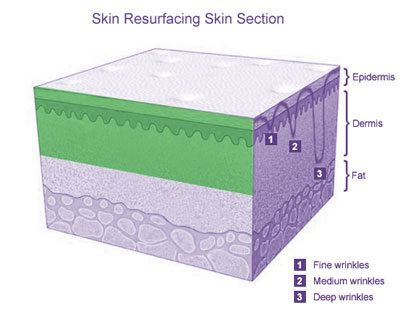
Depending on the area of skin to be treated and the type of laser system used, different treatment procedures may be recommended for you by your practitioner.
Your first discussion with a practitioner should clearly set out your expectations of the laser treatment and whether your medical practitioner believes that he or she can achieve this for you.
A medical history should be taken at this time to make sure that there are no reasons why you shouldn’t have the treatment. You would normally be asked to read detailed information and sign a consent form which means that you have understood the potential benefits and risks associated with the procedure recommended for you.
Photographs may also be taken by the practitioner for a "before and after" comparison at a later date.
Treatment procedure for ablative laser skin resurfacing
Two main types of laser are used for skin resurfacing - the Carbon Dioxide or CO2 laser and Erbium Yag lasers. Both of these lasers operate in a wavelength (or colour of light) that is attracted to water molecules contained in the skin.
Recommendations a week before the treatment may include stopping taking any aspirin or nonsteriodal anti-inflammatory drugs (NSAIDS) to reduce bleeding following treatment (especially if an Erbium Yag laser is used).
Some practitioners like to test a patch of skin before the full treatment to familiarise the patient with the technique and educate them about the healing process. The skin test will also check for any tendency for pigment change or scarring in your skin.
Many practitioners will recommend some form of pre-treatment to the skin 2 weeks before the procedure; these can include retinoic acid, or alpha-hydroxy acid based creams, which help to condition the skin and improve healing after the operation.
The full procedure usually involves the use of local anaesthetic on the area to be treated, and for larger treatment areas this may be combined with some form of sedation to make you drowsy during the procedure and to lessen any discomfort.
Before laser resurfacing, the skin surface is treated with an antiseptic and gently cleansed. Surrounding hair is protected with wet gauze, and eye shields should be worn.
If the eye area itself is to be treated, then intraocular stainless-steel eye shields are usually recommended to ensure that your eyes are fully protected from the laser.
If you are not sedated, be prepared for a loud cracking noise when the laser is being operated as the beams are emitted onto the surface of the skin. Do not be alarmed: this is quite normal!
Depending upon the type of laser used this procedure can take from 15 - 30 minutes, for smaller areas of treatment, to over an hour for full face resurfacing.
Repeat procedures
Depending upon the depth of treatment, and recovery time, those wrinkles or scars that haven’t been improved satisfactorily, can be treated a second time. This can take place 6 to 12 months after the first treatment.
Most people find that they can return to work after a couple of weeks.
Immediately after laser skin resurfacing, you will have a raw, uncomfortable and weeping surface burn in the area treated. This will take 3 – 8 days to heal, depending on the extent and depth of the procedure and your healing capacity.
Side effects or risks after the procedure can include infection, itching, swelling and pain at the treatment site.
Skin erythema (redness) will last from several weeks to 6 months following the procedure. In rare cases, this redness can continue for longer.
Milia (small raised cysts which look like white spots) usually occur during the first 6 - 8 weeks after treatment, and may remain from a few days to many weeks after the treatment.
Hyperpigmentation (increased pigmentation or colour in the skin) can occur in the area treated, particularly in those with darker skin types.
Hypopigmentation (decreased skin colour) can also occur. This is less common and appears to be related to the depth of treatment, but can occasionally be permanent.
Rarely, scarring of the skin can occur, which in some cases can be permanent.
It is very important that you follow the advice of your practitioner carefully after any laser treatment to help the procedure to be successful and to reduce the risk of complications.
Post treatment advice may include:
Patients generally not suitable for any form of laser treatment are those who have a history of keloid scarring, an active herpes infection (cold sores) or other skin infections such as impetigo on the area to be treated.
Patients who have used the drug isotretinoin in the last year, would also not be suitable candidates.
Patients who have diabetes mellitus should be cautioned before embarking upon laser resurfacing procedures because laser treatment can increase the possibility of infection and delay the healing of the wound.
Patients with darker skin types may not be suitable for deep laser resurfacing because of changes to skin colour which can happen to them after the procedure.
A suitably trained and experienced doctor or surgeon should perform all treatments that involve skin resurfacing using ablative lasers.
Please also note that all clinics offering laser treatments should be registered with the Care Quality Commission. Clinics need to follow certain standards for the safe operation and maintenance of these machines, and receive regular inspections to ensure that national minimum standards are followed.
For more information about practitioner training, qualifications and relevant medical organisations please view the information contained within the Legislation section of the Consulting Room.
It is highly unlikely that anyone considering ablative laser skin resurfacing would be able to access this free of charge on the National Health Service.
However certain regions do make special cases, and we would always recommend that you visit your General Practitioner before embarking upon a cosmetic procedure involving surgery.
As well as their advice and guidance they may also be able to refer you to a local NHS Hospital for a consultation.
The NHS has set out the following guidelines on how to get cosmetic surgery through the NHS:
"To qualify for surgery on the NHS you must meet specific criteria as set out by your local health authority. The NHS will not pay for surgery for cosmetic reasons alone. Reconstructive and cosmetic surgery to correct, or improve, congenital abnormalities and injuries will usually be carried out free of charge.
NHS reconstructive surgery is performed by plastic surgeons who have had extensive training and belong to the British Association of Plastic Reconstructive and Aesthetic Surgeons. Surgeons who carry out cosmetic surgery through the NHS also belong to the British Association of Aesthetic Plastic Surgeons.
To receive cosmetic surgery from the NHS, you will normally need a referral from your GP. You will have a consultation with a plastic surgeon and an assessment by a psychiatrist, or psychologist. It will then be decided whether there is enough social, psychological, or physical benefit to be gained to justify surgery."
Prices for a private laser skin resurfacing procedure can range from around £1,000 for a small area to around £4,000 for full face laser skin resurfacing.
Traditional ablative laser skin resurfacing has been shown to be very effective in improving deeper lines and wrinkles associated with sun damaged skin.
The downside is the recovery time, cost, and potential complications.
As a consequence of this, the development of lasers has focussed on so called non - ablative laser and IPL light sources that do not remove the surface of the skin, but still cause visible improvement of lines and wrinkles.
These alternatives do not, as yet, produce such dramatic and long lasting results as ablative lasers, but they are safer and involve virtually no recovery time.
Please see our laser/IPL/LHE skin rejuvenation section for more details.
You will often find that your practitioner recommends the use of botulinum toxin (Botox®) at the same time as a laser treatment. This is to reduce creasing of the skin around the eyes or forehead during the healing process.
Obviously, this is only necessary for those who have had treatment in these specific areas. Botox® helps the skin to heal and also reduces the chances of reappearance of crow’s feet or forehead wrinkles after the procedure.
Results vary enormously depending upon both the patient and the skill of the individual surgeon, so outcomes for cosmetic surgery procedures will always be more variable than those for less invasive non-surgical treatments.
Results with Pearl™ YSGG, Images provided courtesy of Cutera UKLtd.
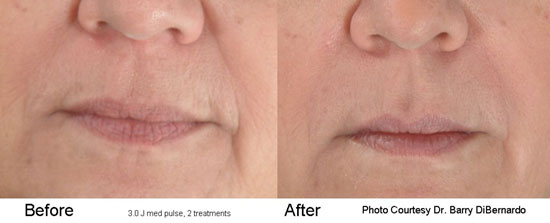
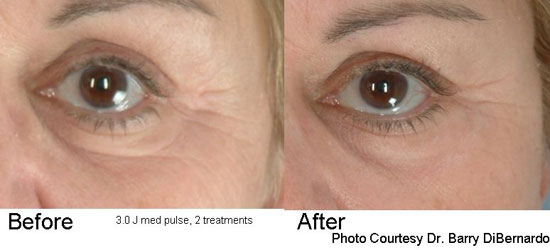
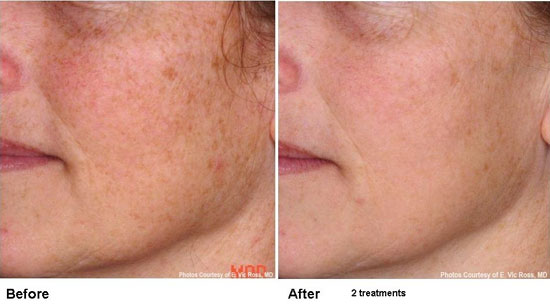
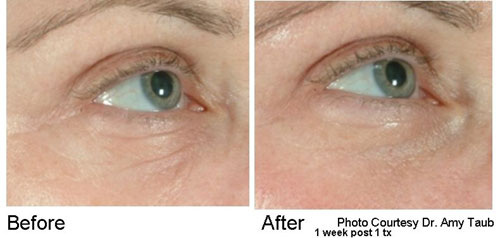
All before and after photographs are real patients, your results may differ.